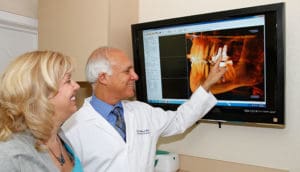The following is an answer to a question that I was asked on another forum. I hope it will help you:
Our initial examination lasts 2 hours. Only 30 minutes of that is doctor time.

Our assistants review the intake documents that were prepared by our phone staff as well as the phone call that the doctor makes to the patient prior to the patient arriving for his or her appointment. So there is a reasonable amount of preparation work prior to the patient arriving.
The assistant will spend about 40 minutes doing x-rays, medical history, and initial assessment of the patient’s problem. Some education is done prior to my arriving in the operatory.
For most patients, I’m able to assess and develop a complete treatment plan with alternative options within that 30 minute period of time. That is a skill that took me some time to develop. More on that later.
I dictate those treatment plans to the assistant. I also give a brief overview of the treatment plans to the patient before turning over the detailed explanation to my treatment coordinator. For some who are more complex, I need more time and may set up a separate consultation visit. So the patient spends at least 60 minutes with the treatment coordinator after completing the examination with me.
I do use well trained assistants/treatment coordinators. We have training manuals and videos for every specific aspect of our office ro incluse treatment plan presentation. Our treatment coordinators have such training in order to be able to deliver the type of service that we want. In addition, we send all of our staff for communication and sales training.
My goal is a professional atmosphere where there is sufficient time for the patient and the treatment coordinator to discuss treatment, particularly treatment options, before deciding on the treatment that is best for that patient.
That may require even more than the allotted time for discussion with the treatment coordinator, but the treatment coordinator is so well versed that she can usually answer any questions. If we orchestrate this correctly, the confidence that the patient places in the doctor can be transferred to the assistant. It is a matter of training and sequencing.
There are times when I’m called back into the treatment coordinator room to be able to answer specific questions. There are also times when the patient wants an alternative plan or further explanation from me. If that’s the case, we schedule another visit with me to discuss options that may not have been covered when I did the initial treatment plan or treatment plans.
This, of course, is done at no charge to the patient.
For periodontal diagnostics, I rely on the Oral DNA test. I use that on the majority of cases on a prospective basis. I think it’s very helpful for the patient to know the periodontal pathogens that are involved in the patient’s disease process and the implications of those pathogens.
There is an additional fee for those tests which include the fee for the test itself as well as time for the doctor to discuss the test with the patient.
I believe that comprehensive treatment planning is the job of the periodontist. Therefore when we are delivering such a treatment plan, we’re not just talking about perio or implants. We’re talking about the entire treatment plan to include restorative dentistry along with the fees associated with that restorative dentistry.
I want the patient to have a complete picture, and I want the complete picture coming from me.
This is a learned skill. The first part of that skill is the desire to treatment plan the full case at the first session. For a perio case, that likely is easy.
However, when you get to over closed cases and combination therapy, that takes longer to learn so you may need a second visit. But we want to get to the point where we can estimate sequence and cost even if we are referring for orthodontic, endodontic, and prosthodontic care.
Occasionally, I want the input from the entire team of specialists before presenting to the patient and even then, I outline the treatment sequence that I’m thinking about at the chair and send that sequence to the specialists for their input.
I’ve named this process and goal Director of Dentistry.
I hope that this answers your question. Please don’t hesitate to ask further questions for clarification purposes.
